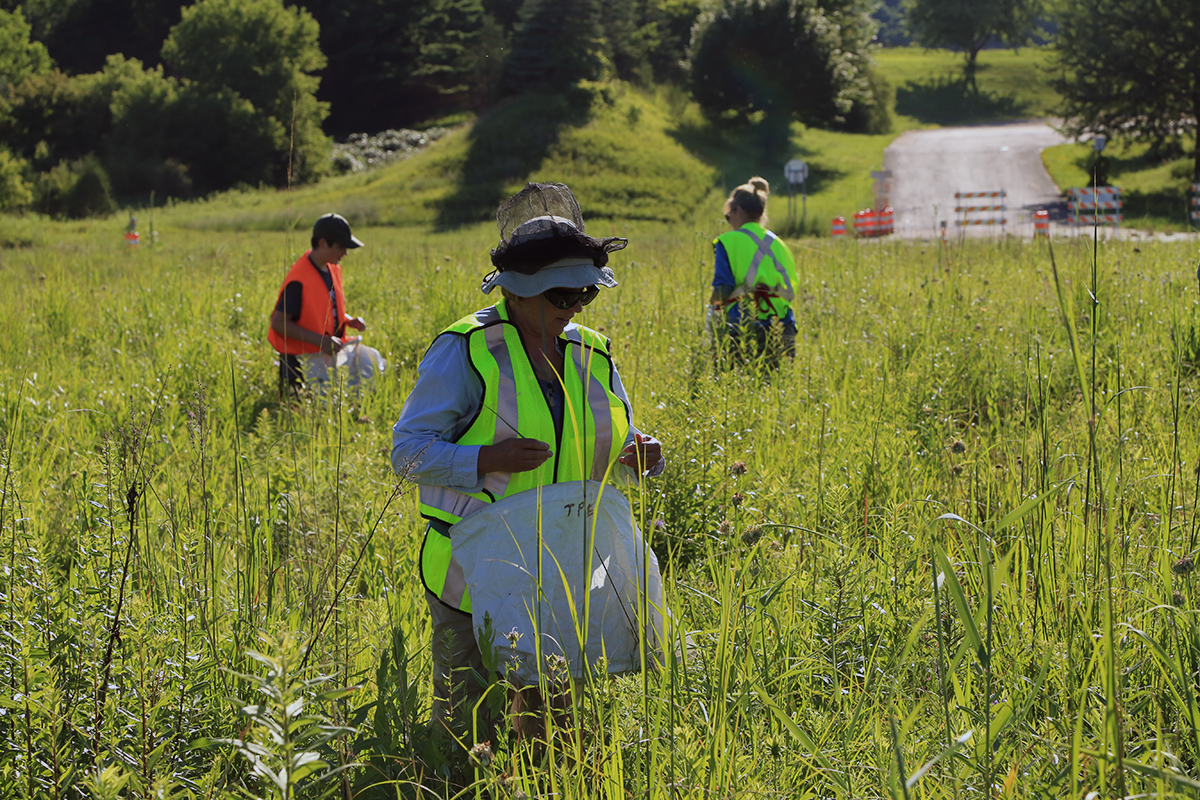By Joseph Palmersheim

These volunteers with Prairie Enthusiasts of St. Croix Valley, one of five volunteer groups partnering with MnDOT’s Highway Sponsorship program, are working on an area south of Bayport known locally as “Blueberry Hill.” The program works with businesses, civic organizations and individuals to improve and maintain property on the highway system. Photo by Evanne Hunt |
Fall is Evanne Hunt’s favorite time of the year to visit “Blueberry Hill,” a 10-acre parcel of land south of Bayport near the St. Croix River.
“I love standing in this little prairie and watching the grasses wave in the wind,” said the board president of the Prairie Enthusiasts of St. Croix Valley. “I tune out the traffic and tune in the calls of the hawks and song sparrows; maybe even the rapping of a piliated woodpecker.”
But Hunt and other Prairie Enthusiasts aren’t simply visitors – they are caretakers. And after caring for the area with limited permits or agreements for the past 15 years, they are now working with MnDOT as partners.
Blueberry Hill is one of five highway sponsorship projects connecting MnDOT with local volunteer organizations to enhance and maintain right of way property since the program launched in 2019.
The Highway Sponsorship program works with businesses, civic organizations and individuals to improve and maintain property on the highway system. This can include landscaping, creating pollinator habitat and other aesthetic and environmental projects along highway roadsides.
The sponsoring organization is responsible for underwriting the full cost of the project, including the cost of landscaping design, purchase of plant material, installation and on-going maintenance activities. Highway Sponsorship Licenses are typically 2-5 years in duration, or up to 10 years. Sponsored projects may be eligible for a roadside “Beautify Minnesota” sign displaying the name or logo of the partner organization.
It’s a win-win, said Jessica Oh, Strategic Partnerships Director, Sustainability and Public Health Division.
“This program allows us to form partnerships with nonprofits, for-profits or individuals to do the maintenance work we don’t have capacity to do,” Oh said. “For creating pollinator habitat, this is authorizing the work to occur safely and working collaboratively to develop robust, long-term maintenance strategies with community-based partners. It’s new territory for us in the sense that we’re collaborating on prescribed burns, on vegetation maintenance strategies and jointly addressing illegal dumping issues. Highway sponsorship can cover a huge range of different maintenance activities.”
Sponsorship replaces case-by-case and annual permitting approaches. The new system offers a balance of right of way control and access, Oh said, with a focus on risk assessment and developing a long-term relationship with community organizations.
Partnership might not be the only thing to blossom as a result of the program. Some of Blueberry Hill’s native plant seeds may end up at other pollinator habitat sites across the state. The Prairie Enthusiasts are sharing part of each year’s hand-collected native seeds with MnDOT. These seeds will be used on other prairie habitat restoration projects in MnDOT right of way to support pollinators. Highway sponsorship is a way to activate maintenance partners to support critical habitat on highway roadsides.
“When we have high-quality pollinator habitat in our right of ways, it can act as an important connector to other habitat restoration projects for species like the monarch butterfly or rusty patch bumblebee,” Oh said. “As we invest in pollinator habitat, we have a great opportunity to proactively seek maintenance partnership for projects, and that’s a big shift for us. Partners on the ground will lead to better outcomes with our projects.”
Learn more: dot.state.mn.us/highway-sponsorship
| 


